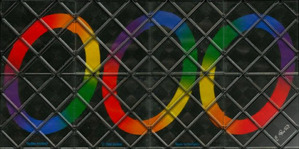 ( ... in italiano)
( ... in italiano)
Last updated: July 22, 2025.
Rubik's magic constructible configurations
Unlike other classical puzzles like the Rubik's cube or the more
basic fifteen puzzle of Sam Loyd, obtaining all possible
constructible configurations of the Rubik's magic is not an easy task.
Apparently simple configuration often require moves through
quite involved 3D shapes.
Proving that some configuration can be constructed requires an actual
construction.
Proving that some configuration cannot be constructed requires the
definition of a suitable invariant that is violated.
In particular enforcing two such invariants (so-called metric and
topological invariants) we obtain a set of feasible
configurations; we cannot state that they are constructible unless
we are actually able to construct them.
Moreover, the set of constructible 3D configurations is infinite; too
much to be studied completely.
We are then forced to restrict to special (finite) subsets.
Generalizing the notion of polyominoes (the game tetris uses the complete
set of tetrominoes) in 3D we can focus attention to those configurations
of Rubik's magic corresponding to eight unit squares with mutual orthogonal
angles (or mutually coplanar).
The concept of octominoid configurations was first introduced by Jürgen Köller in
http://www.mathematische-basteleien.de/magics.htm.
In this case all feasible configurations have been actually constructed,
so that we have the
complete set of constructible configurations corresponding to 3D
octominoids (click on link above).
Consist of all configurations with all tiles lying on a plane, possibly
including stacked tiles, and all tiles oriented face-up (this
excludes in particular the flat shapes below). In this set there are
still a few configurations that are feasible but not (yet) actually constructed,
so that we do not have the complete picture of constructible configurations.
Configurations consisting of four stacks of two superposed tiles,
one face-up and one face-down, in the overall shape of a tetromino.
These have been described in [Nourse], to which we
add the U flat shapes.
Click on link above for a list and instruction to construct them
Interesting configurations
 the cube
the cube
 armchair
armchair
 hard-to-reach planar shape
hard-to-reach planar shape
References
- Wikipedia page.
-
[Koeller] Jürgen Köller, Rubik's Magic
(web page).
-
[Jaap] Jaap Scherphuis, Rubik's Magic Main Page
(web page).
-
[Houlis] Pantazis Constantine Houlis, Folding Puzzles
(web page).
-
[Nourse] James G. Nourse, Simple Solutions to Rubik's MAGIC,
Bantam Books, 1986.
- [Paolini] Maurizio Paolini, Exploring
the "Rubik's Magic" Universe.
Recreat. Math. Mag., 4 (2017), 29-64.
- Verhoeff, Tom (1987). "Magic
and Is Nho Magic" (PDF). Cubism For Fun (15): 24–31. Retrieved 2015-07-28.
Other resources
Feedback: Email address on my main page
URL of my Homepage:
http://dmf.unicatt.it/~paolini/
© 2014 Maurizio Paolini






 the cube
the cube
 armchair
armchair
 hard-to-reach planar shape
hard-to-reach planar shape